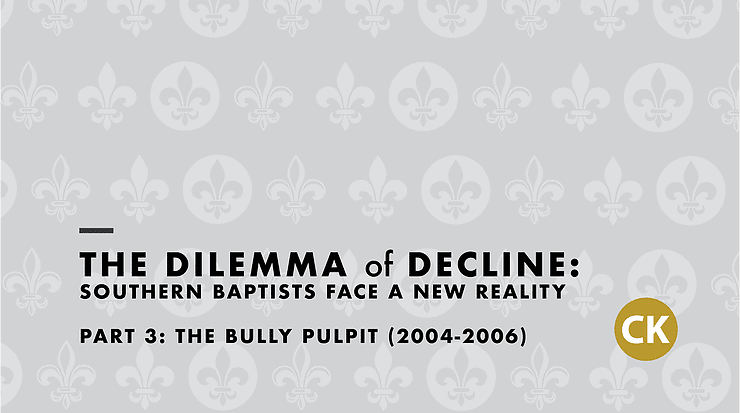By Dr. Chuck Kelley
With the dawning awareness of the decline creeping into Southern Baptist churches came a slowly growing determination to turn things around. Over the next two decades, five distinctive approaches to ending the decline were undertaken. Each approach was unrelated to the others, a factor which may have affected their effectiveness. These approaches were: the SBC president’s use of his position as a bully pulpit to emphasize evangelism (2004-06); a National Evangelism Initiative (2008); the Great Commission Resurgence (2010); the Pastor’s Task Force on Evangelistic Impact and Declining Baptisms (2014); and the Evangelism Task Force (2018). What follows in this and future blogs is a brief description and assessment of each approach in an effort to discover what we can learn about how to help the diverse and loosely organized churches of the SBC find ways to reach their communities for Christ and begin to grow again.
The Bully Pulpit (2004-2006)
The instinctive response of Southern Baptists to major issues and challenges has always been to address them through preaching. The President of the Southern Baptist Convention traditionally preaches more widely and more often to a greater number of Southern Baptists each year than any other SBC preacher. Typically, he is invited to speak at all six seminaries, every state convention, and many other events, along with countless numbers of church services. Whenever he is on a program, he is the headliner. Every possible accommodation is made to schedule him as often as possible in as many places as possible. The Convention’s publisher typically publishes a book on whatever topic he chooses to address. Any SBC outlet will publish virtually any article he chooses to write. It is a “bully pulpit” unlike any other in Southern Baptist life, allowing a president to push an agenda of his choosing. Throughout his term of service, which is a maximum of two years, the SBC president will be heard across the Convention, and he will be listened to with respectful attention.
Most of those serving as SBC president since 2001 were known for their commitment to evangelism and evangelistic preaching. Each intentionally used the bully pulpit of the SBC presidency in some way to call Southern Baptists back to the priority of evangelism and the need for revival. None used the role of president to promote and encourage evangelism more aggressively with greater passion and wider reach than Dr. Bobby Welch. From the moment the gavel fell to end the 2004 Convention, making him the official President of the SBC, until the last moment of his term of service in 2006, he traveled to every nook and cranny of the SBC, using every possible opportunity to call Southern Baptists to deeper, wider, and more effective engagement in reaching the lost in their communities for Christ.
Dr. Welch took the unprecedented step of leaving his church in Florida and moving to Nashville, TN (administrative heart of the SBC) in order to give the evangelism problem his undivided attention for the two years of his presidency. He went so far as to do something usually frowned upon by many Southern Baptists. He arranged for a local church in the host city of the Convention to conduct a baptism service on the floor of the SBC during a session as a dramatic emphasis on the need to reach the lost.
President after president for two decades included one or more aspects of evangelism as a focal point of his presidency. However, the use of the bully pulpit alone by any Convention president did not reverse, or slow down the decline settling into SBC churches. The amount of exposure for the presidency is immense, but momentary. The President would most often speak to the group in front of him and then go on to his next engagement. According to Baptist polity, he has the authority to command attention, but he does not have the power to require decisive action. Further, he has no power to command attention or require action after he completes his term of service and hands the gavel to the next President. When his term expires, he is done.
The SBC President does not preside over anything but the annual meeting of the Southern Baptist Convention, and he does not do that for the first time until the end of his first year of service. His second opportunity to preside comes as his term of service ends. When the gavel falls at the end of year two, the bully pulpit is transferred to another. The bully pulpit is a very powerful tool, but two years is a short amount of time to orchestrate a major transformation. Presidents learn Southern Baptists are quick to listen but slow to act.
The lone exception to the problem of momentary influence was the Conservative Resurgence. The brilliant strategy developed by Dr. Paige Patterson and Judge Paul Pressler used the bully pulpit of the presidency to great effect by asking recommended presidential candidates to make a pre-commitment to theological transformation at a structural level through a specific action plan using the appointive power of the president. This plan required multiple presidents acting in concert for at least a decade to succeed. Transparency was also a critical element, as those involved in the movement freely discussed with Southern Baptists what they were doing and why they were doing it. President after president executed the action plan in turn until the desired result was accomplished, ushering in an era of profound theological change that reshaped the Convention and all of its entities.
Using the bully pulpit without a connection to a sustainable, continuing action plan to address the evangelism crisis did not have any comparable effect. The greatest contribution of the bully pulpit of the presidency was to make SBC leaders and pastors aware that decline was a dilemma unlike any other. Up next: a national evangelism initiative.
Pastor’s Take Away: What you preach in your pulpit really does matter, but it will make a greater impact if it is connected with action, with a strategic plan outside the pulpit. In your sermon preparation, ask: “How does this sermon connect with an evangelism or ministry action plan?”





